The verdict: The 2017 Acura MDX Sport Hybrid is more sport SUV than hybrid SUV, but it's not without its quirks.
Versus the competition: The MDX Sport Hybrid isn’t just about boosting fuel economy, which sets it apart from many hybrid SUV competitors.
Acura's 2017 MDX Sport Hybrid is packed with enough technology to make a techie tingle all over at the prospect of explaining its complicated innards to guests at a backyard barbeque. Three electric motors, electronic torque vectoring, a dual-clutch automatic transmission and electro-servo braking are enough to bore the pants off the neighbors, who are just there for the burgers and beer.
But if you're into this kind of stuff, it's pretty cool. The technology stuffed under the MDX Sport Hybrid is not your typical hybrid technology geared toward increasing fuel economy. Rather, it's designed to provide a new kind of driving experience, with a single electric motor up front attached to the transmission and two motors in back. This hybrid system debuted in the Acura RLX Sport Hybrid sedan and was fully realized as a performance enhancer in the Acura NSX supercar.
Surprisingly, Acura crams all the MDX's hybrid components underneath the SUV, without sacrificing cargo or passenger room. Read our review of the non-hybrid MDX here for a more comprehensive review of the updated 2017 version. For this review, I drove a 2017 MDX Sport Hybrid with the Advance Package, priced at $58,975 including destination charge; an MDX Sport Hybrid with the Technology Package starts at $52,935.
Acceleration and Braking
Under the hood of the MDX Sport Hybrid is a smaller, 3.0-liter V-6 engine (the regular MDX has a 3.5-liter V-6), but there's more total output when you factor in the hybrid's lithium-ion battery juicing the three electric motors for a combined 321 horsepower and 289 pounds-feet of torque. That's up 31 hp from the regular MDX's 290-hp engine, and it's an extra 22 pounds-feet of torque versus the MDX's 267. Compare the Sport Hybrid's specs with the regular MDX here.
Surprisingly, Acura crams all the MDX’s hybrid innards underneath the SUV, so cargo and passenger room isn't sacrificed.
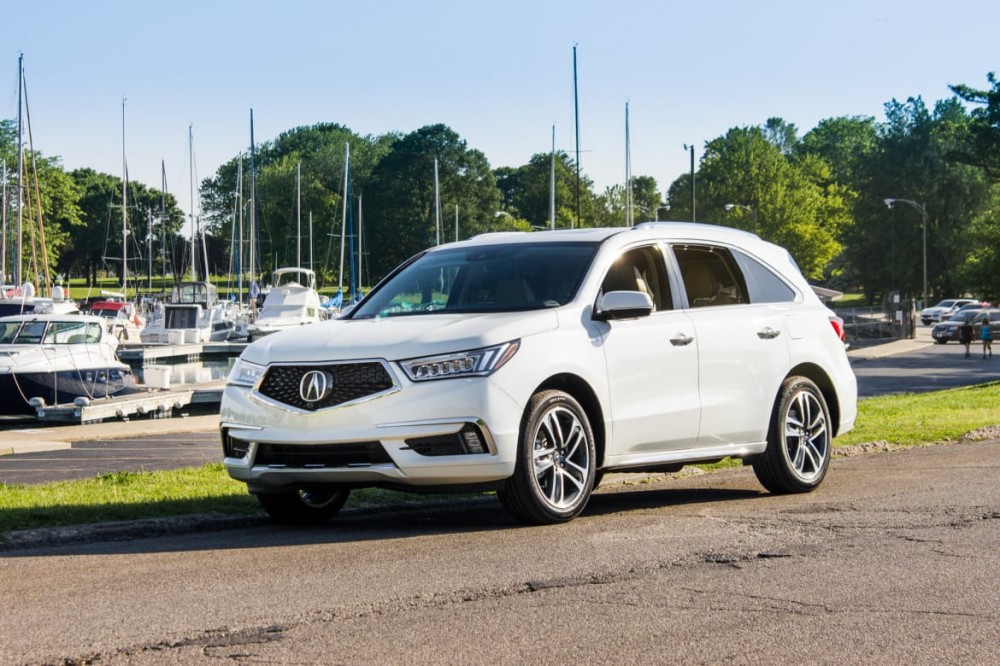
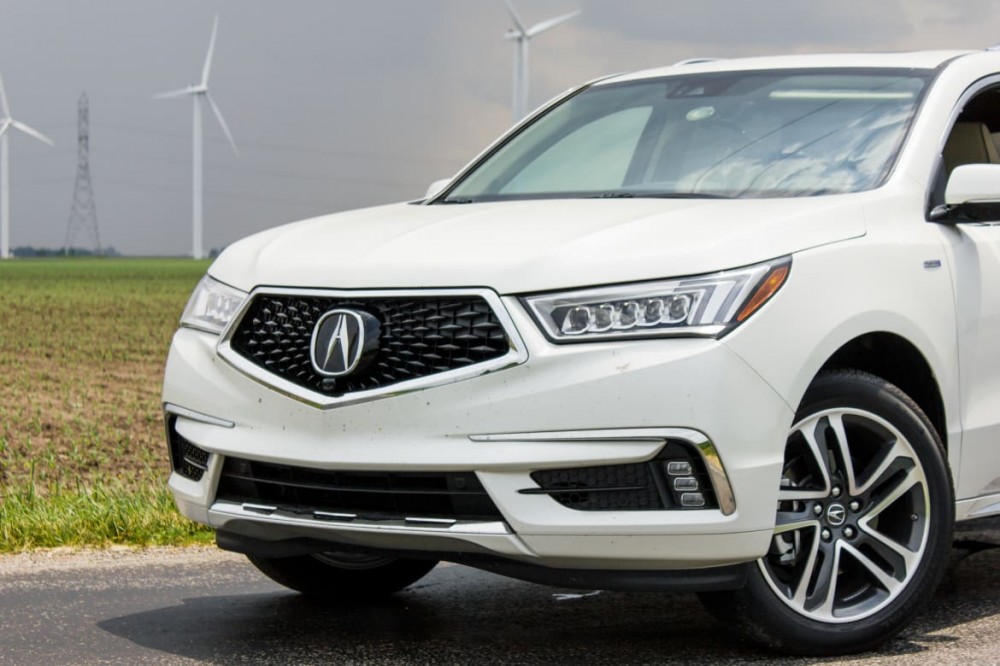
Outright acceleration in the Sport Hybrid isn't appreciably different from the non-hybrid, as some of the extra power is sapped by the hybrid's additional 227 pounds over a comparable gas-only MDX (4,484 versus 4,257 pounds). Accelerating from a stop and at low speeds produces a bigger difference; there's an instant jolt of acceleration from the instantaneous electric assist. The various driving modes of Comfort, Normal, Sport and a hybrid-unique Sport+ deliver a wide range of acceleration responsiveness, as each varies how much assist the hybrid's electric motors provide.
In Sport+, full battery assist is enabled, electric-only mode is disabled and gas-pedal response is quickened for crisp and potent acceleration. Stoplight-to-stoplight city driving is more engaging with the punch that comes from Sport+ mode. A regular MDX is no slouch, but it requires more revs to fully realize its power; the Sport Hybrid's acceleration is on tap from the get-go.
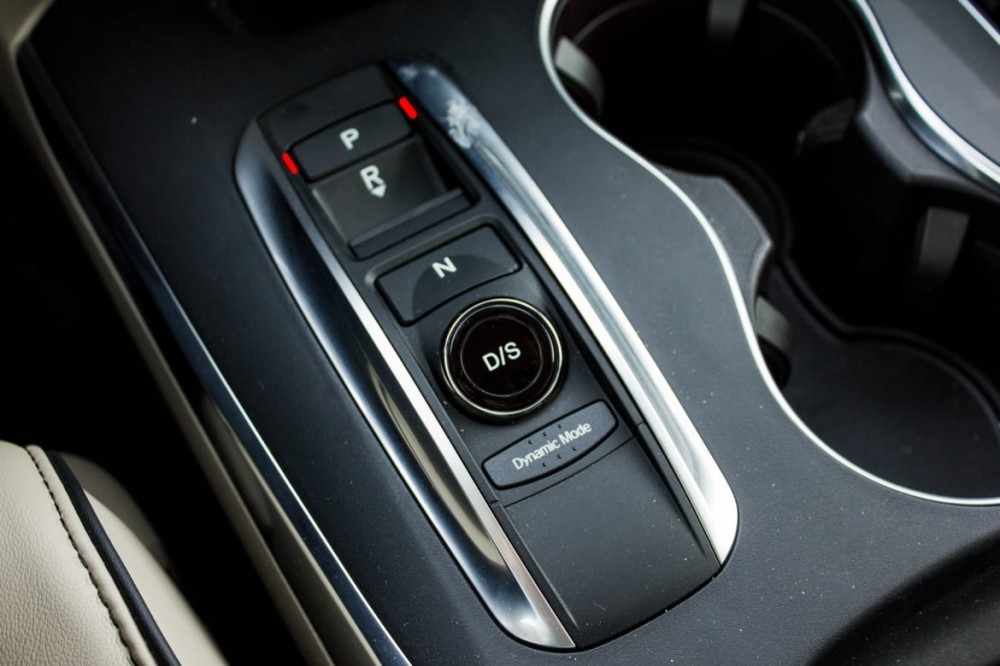
A seven-speed, dual-clutch automatic transmission replaces the conventional nine-speed automatic found in the regular MDX. This is a change that should have happened throughout the MDX lineup; the seven-speed (which is constructed like a manual transmission) is lightning-quick, crisp and never hesitates or feels funky, as the nine-speed has in our testing. Unfortunately, the wonky gear selector remains. Even after a thousand miles behind the wheel, I still tried to engage Drive by pulling back on the Reverse button. Pulling back to engage Drive is a standard motion on every other automatic-transmission car with a traditional PRNDL, console-mounted gear selector, but in the MDX that motion engages Reverse. It takes a lot of conditioning to use the gear selector correctly.
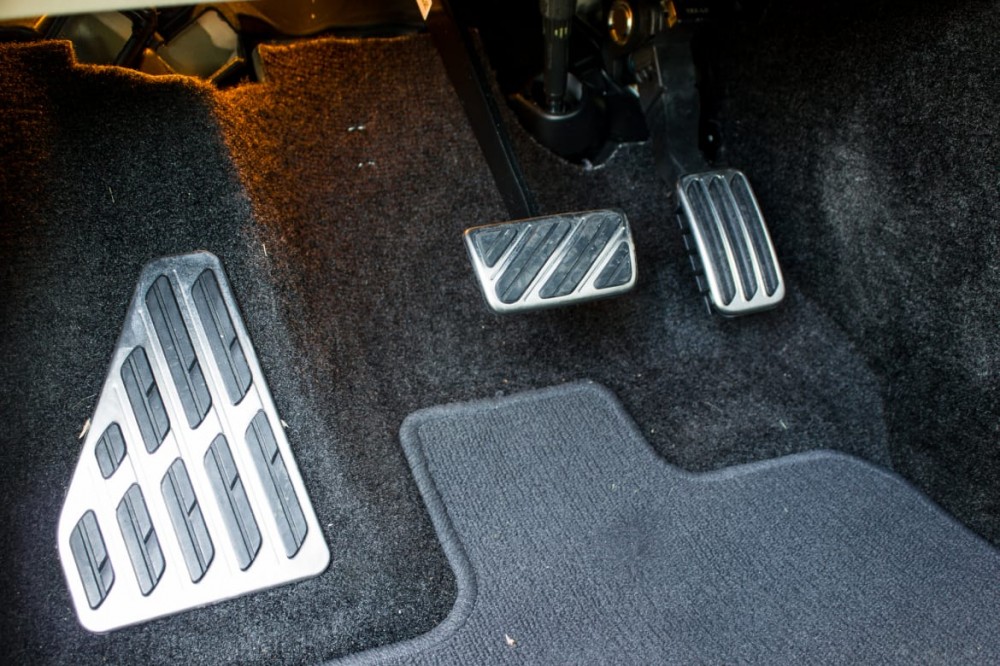
In Acura's NSX supercar I was blown away by how natural the electro-servo braking system's pedal felt given it's not a conventional braking system. In the MDX hybrid, this system is anything but a natural experience; it's more binary in operation. The brake pedal is difficult to modulate, which makes slow-speed braking jerky. At higher speeds, it takes more brake-pedal pressure than I would have guessed to slow down, which made for some unsettling stops.
Fuel Economy
Fuel economy increases from a high of 22 mpg combined for an all-wheel-drive, non-hybrid MDX to a high of 27 mpg in the Sport Hybrid. This 5-mpg gas-mileage increase is a notable 23 percent improvement, but it's not as substantial as the 2017 Lexus RX 450h's 8 mpg increase — a 36 percent increase for the 30-mpg-combined RX 450h compared with the gas-only RX.
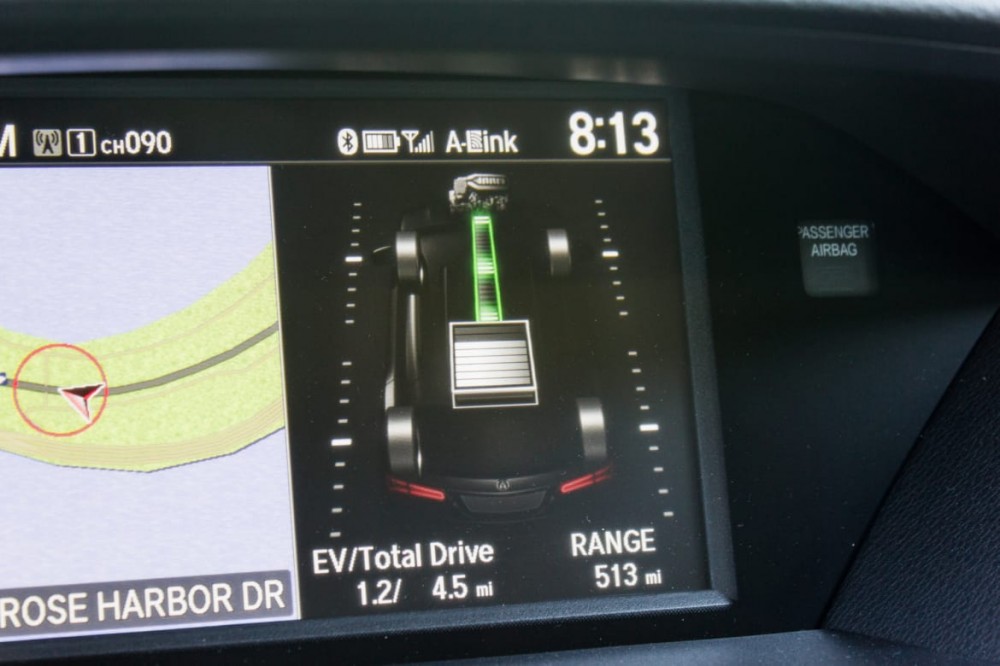
In our testing, the MDX hybrid's 27 mpg combined rating proved perfectly achievable. In fact, we consistently measured 27-28 mpg in it regardless of city or highway driving, which jives with its 26/27 mpg city/highway rating. Read more about our MDX Sport Hybrid fuel economy testing here.
Though the MDX Sport Hybrid's combined fuel economy estimate is lower than the five-seat RX 450h's 30 mpg combined rating, it's slightly better than the seven-seat Infiniti QX60 Hybrid's (26 mpg combined with all-wheel drive). Compare the MDX's specs with the RX 450h and QX60 Hybrid here.
Handling and Ride Quality
The regular MDX with all-wheel drive is already one of the better-handling three-row SUVs in its class thanks to an intelligent all-wheel-drive system — Super Handling All-Wheel Drive — that transfers power not only between the front and back wheels, but also side-to-side between the rear wheels for improved handling. The hybrid's all-wheel drive does the same, but there's no mechanical link between the front and rear wheels, so the same effect is created by two electric motors at the rear wheels working independently of each other. These two motors enable torque vectoring, so more power can be sent to the outside wheel while cornering to help the MDX hybrid turn better.
The outcome is nimbler handling than the SUV's size suggests. When diving into a corner, the front tires feel like they get a break from turning all that weight while the rear end rotates the car through the turn. While the outside rear wheel is doing its job, the inside wheel captures kinetic energy to recharge the battery pack. It takes a lot of hooliganism to unsettle the MDX hybrid — more than anyone should experience dropping off the kids at school.
The electronic goodness of the all-wheel drive and torque-vectoring systems is complemented by the hybrid-unique adaptive shock absorbers with variable firmness (the regular MDX has fixed-firmness shocks). The Sport Hybrid's shocks have three settings — Comfort, Normal and Sport/Sport+ — that vary ride quality from comfortable, for pleasant highway cruising, to stiff, for tighter and crisper handling. Even in its stiffest mode, the MDX hybrid's ride isn't overly jarring. It's still classic MDX, with better composure on rough roads than the Lexus RX 450h.
Adaptive Cruise Control with Low-Speed Follow
Adaptive cruise control with low-speed follow is standard on every MDX, but I had a troublesome experience with it in the Sport Hybrid, which I believe was simply me finding the limits of the system. While the stop-and-go follow worked fine in a straight line, the MDX I drove had trouble following the car ahead of me in slight bends at low speeds. The owner's manual warns that it has detection limitations, including "When you drive on a curved or winding or undulating road that makes it difficult for the sensor to properly detect a vehicle in front of you."
I believe it. The MDX felt like it stopped tracking the car ahead when we both entered a long, sweeping corner, and I had to panic stop a few times to avoid running into it. It happened during my normal Chicago commute on Lower Wacker Drive and then Lake Shore Drive. Our former long-term 2016 Volvo XC90 and current long-term 2017 Chrysler Pacifica with adaptive cruise control paced traffic just fine on the same roads. Even when the system was working, the MDX hybrid often accelerated too quickly then braked abruptly, creating a jerky ride. Be sure to try this feature during a test drive; maybe your commute is more conducive to it than mine.
Safety
Like the regular MDX, the Sport Hybrid's safety ratings are top-notch. The National Highway Traffic Safety Administration gives the Sport Hybrid five out of five stars in its overall safety rating, while the Insurance Institute for Highway Safety gives the regular MDX its highest status — Top Safety Pick Plus — that IIHS says also applies to the Sport Hybrid.
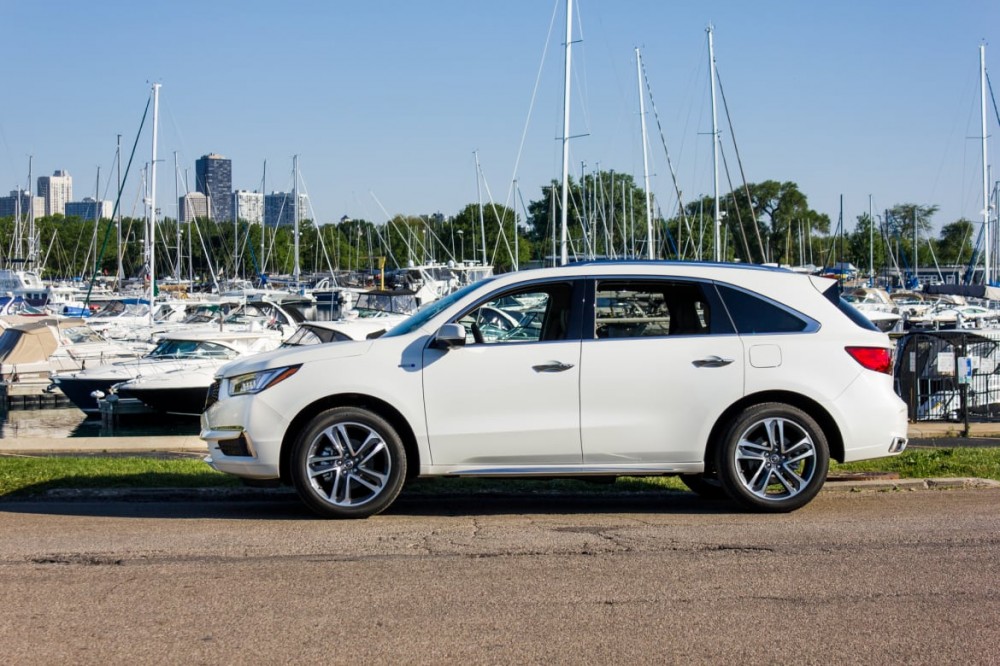
Is the MDX Sport Hybrid Worth the Money?
An MDX Sport Hybrid is only $1,500 more than a comparable non-hybrid MDX. Even though it's not just an economy-minded vehicle, you do stand a chance of breaking even in fuel savings within a typical five-year loan. Fueleconomy.gov estimates an MDX hybrid saves $350 a year in fuel compared with an all-wheel-drive MDX, so in a little more than four years you could recoup the extra cost if the estimated fuel economy is achieved.
The MDX Sport Hybrid is extra fun behind the wheel, and its drivetrain's similarity with a supercar's — the Acura NSX's — is something few luxury hybrid SUVs enjoy. It's not a transformative experience, however, because the regular MDX is already so good. My hesitation from giving it a full-on "buy now" endorsement is due to its wonky brake-pedal feel and inconsistent adaptive cruise control, which hurt the overall appeal of this near-$60,000 SUV.








